The holiday shopping season isn’t what it used to be. Forget the old rhythm of waiting for Black Friday or Cyber Monday: Gen Z shoppers were filling shopping carts in June.
At the same time, a new player has taken center stage: artificial intelligence. From comparing prices and summarizing reviews to generating personalized gift ideas, AI is reshaping how people shop and how brands sell.
In 2025, the holidays have become a year-round algorithmic dance between consumers and machines. Shoppers use AI tools to find deals faster and smarter, while brands rely on automation and data to personalize every click, ad and email.
As a result, the holiday season is longer, louder and more digital than ever, and succeeding means understanding not just what people buy but also how they think, scroll and search in an AI-powered world.
In this guide, we’ll explore how AI is transforming holiday marketing, how Gen Z is changing the meaning of the shopping season and what brands can do to stay relevant and profitable.
Ready? Scroll down to start reading!
Table of contents
Click on any chapter to scroll directly to it.
Chapter 1
Holiday Shopping Starts Earlier Than Ever
Once upon a time, holiday shopping had a clear rhythm: brands dropped deals in November, and shoppers stormed the internet (and stores) over one wild weekend. Those days are long gone.
Today’s consumers, especially Gen Z, aren’t waiting for Black Friday. According to Klaviyo’s 2025 Black Friday & Cyber Monday Forecast:
- more than 20% of shoppers make their first holiday purchase between June and August;
- nearly one in three Gen Z buyers starts holiday shopping before any holiday sales officially begin.
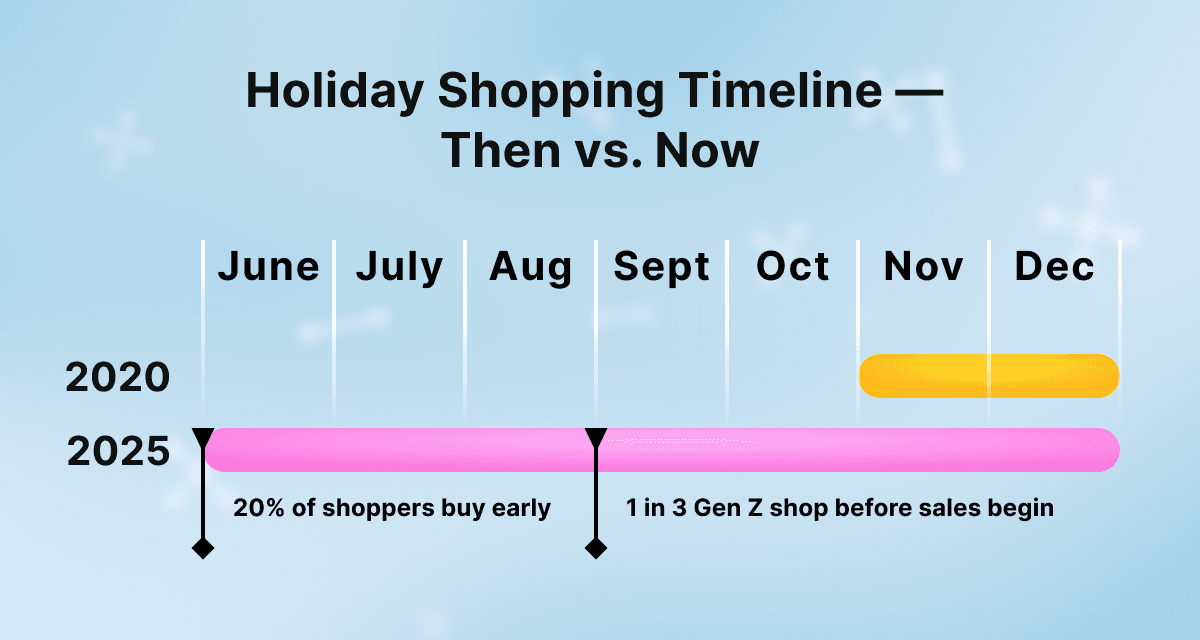
Why the change? People are shopping smarter, not later, and now, AI-powered tools make it easy to:
- track prices across multiple stores;
- get real-time alerts when a favorite product goes on sale;
- receive early personalized recommendations.
And with economic pressure and tighter budgets, it’s clear why shoppers are spreading their spending over several months instead of saving it all for one massive weekend.
For brands, this shift means one thing: the holiday season has turned from a two-day sprint into a six-month marathon. Marketers can’t afford to show up late. Gone are the days of one-off promotions. The winning strategy builds on personalization and maintaining visibility long before the season peaks.
In short: The early bird gets the sale.
Chapter 2
How AI is Taking Over the Shopping Experience
If 2023 was the year of AI testing, 2025 is the year it took over. In fact, shoppers have got an algorithm sitting right next to them.
In the Klaviyo 2025 BFCM Forecast, it shows that 54% of consumers plan to use AI this holiday season to compare prices, search for products, summarize reviews and get personalized recommendations. And get this: 62% would rather use an AI assistant that already knows their shopping history than explain their needs to a real sales associate.
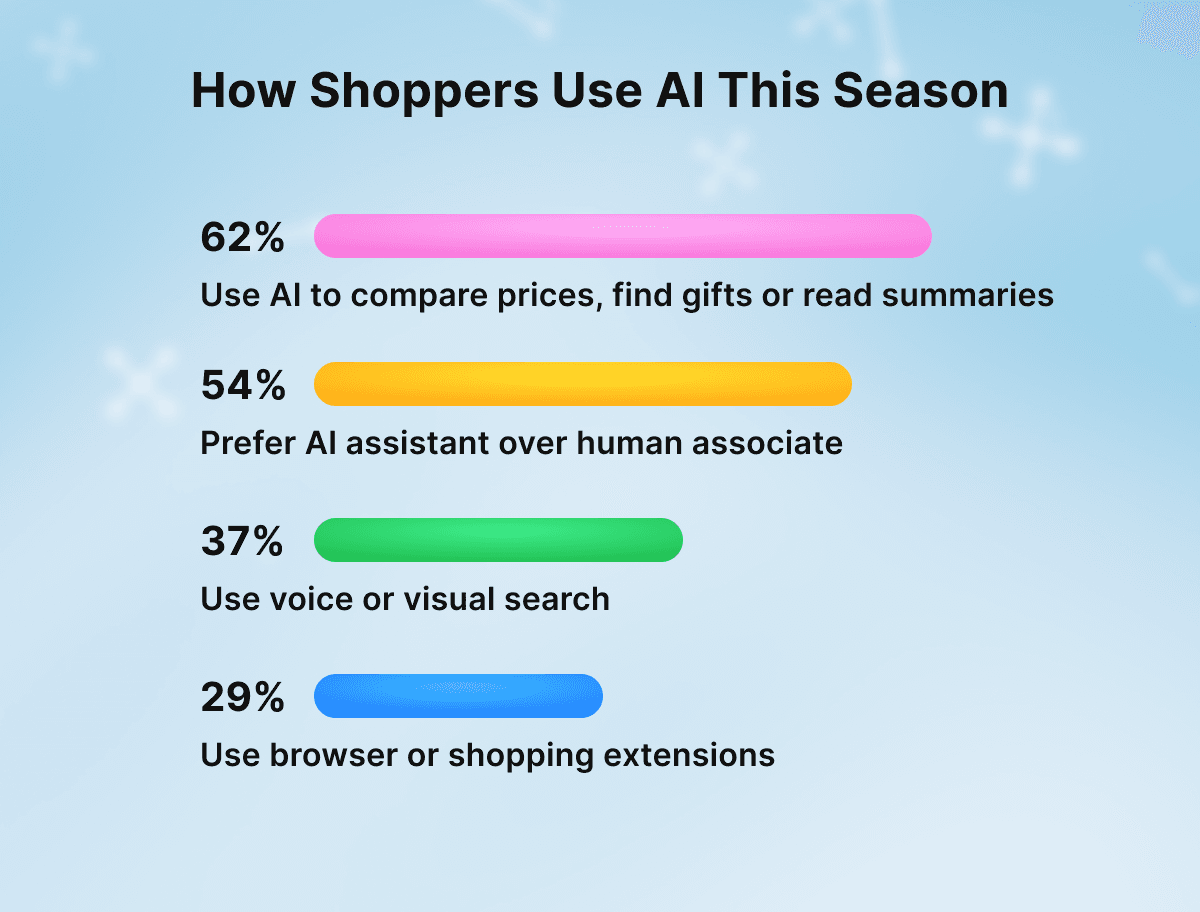
For many shoppers, AI has become the go-to gift advisor, the one that knows your budget, your wish list and that your sister secretly wants skincare, not socks.
Here’s how AI is reshaping the shopping journey:
- Smart search: Shoppers now rely on chatbots or AI search tools that understand natural language (“show me affordable gifts for my eco-friendly friend”).
- Personalized deals: Recommendation engines track browsing patterns and push discounts for items you’ve looked at twice.
- Review summarizers: Instead of scrolling through hundreds of opinions, AI tools now condense them into quick pros and cons.
- Price prediction: Some apps even forecast when a product is most likely to drop in price, helping shoppers plan smarter.
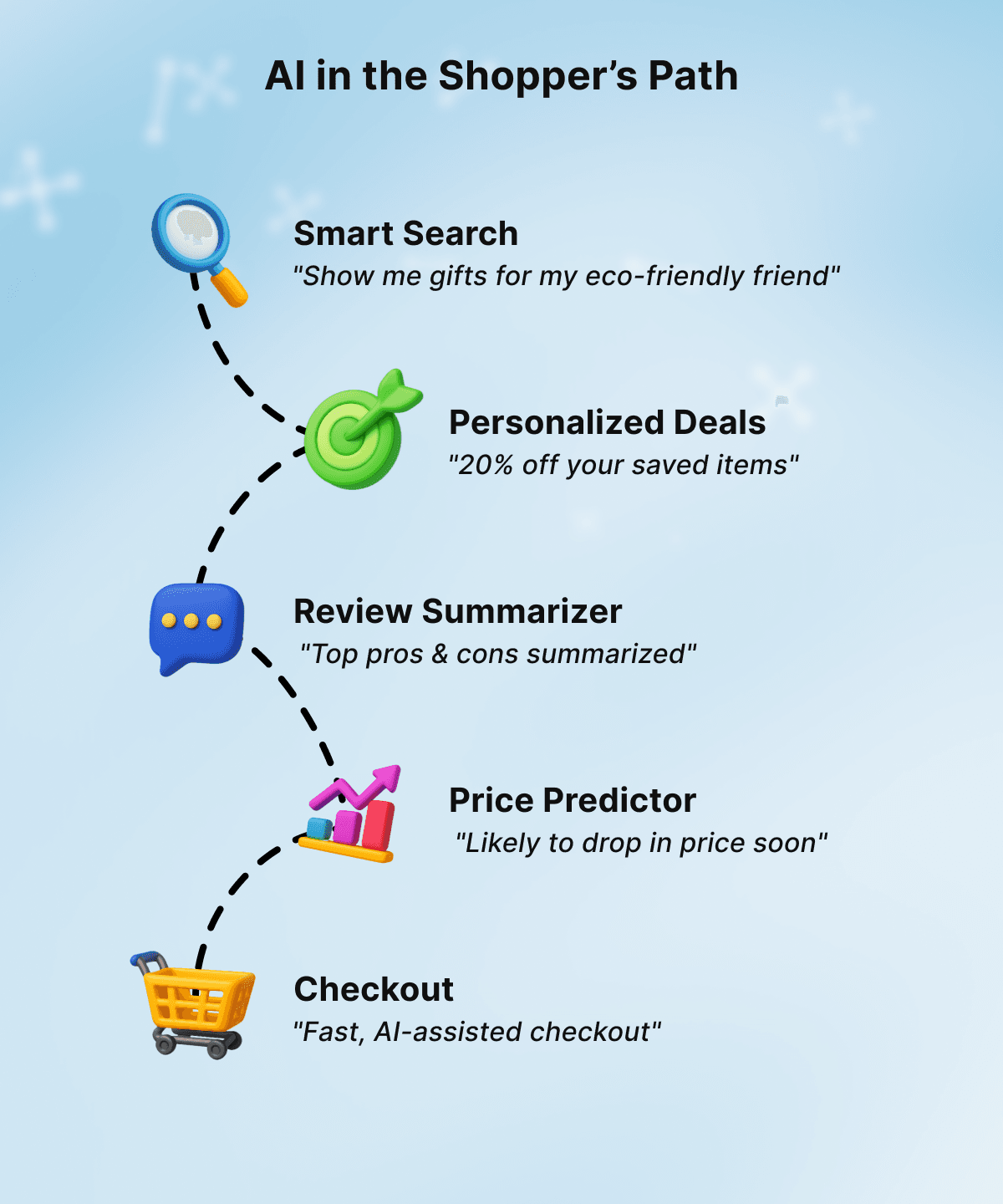
Younger consumers, especially Gen Z, are growing up with AI as a natural part of decision-making. They’re more comfortable letting algorithms guide them than talking to a store clerk.
In short: AI is redefining what “shopping” is.
Chapter 3
Changing Holiday Mindsets: From Buying Things to Buying Meaning
The way people approach the holidays is evolving, especially among younger generations. For Gen Z and Millennials, the season is about moments that matter: meaningful, personal and shared.
According to eMarketer, Gen Z shoppers are less driven by tradition and more by connection. They start shopping early not only to save but also to plan more thoughtful, individualized gifts. They also prefer brands that reflect their values: sustainability, inclusivity and authenticity.
AI is helping make that shift possible. Smart recommendation engines now source ethically made products, eco-friendly options or personalized bundles that feel more unique than mass produced.
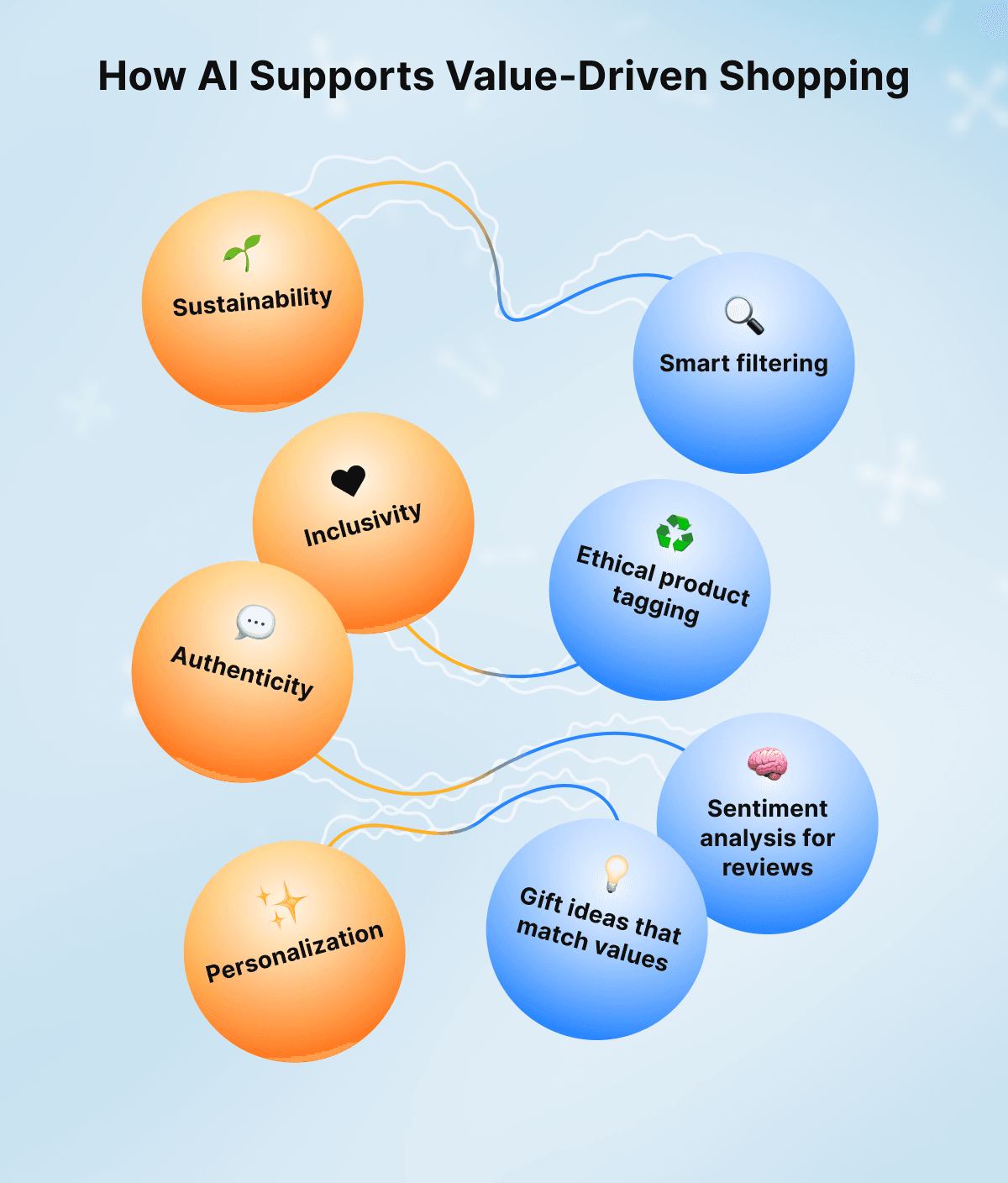
Tip: Use AI to segment audiences by behavior and values. Let it help you match your brand message with what matters to your customers, whether that’s sustainability, small business support or self-care.
Chapter 4
Gen Z Rules the Holidays: How to Speak Their Advertising Language
If Millennials made online shopping mainstream, Gen Z turned it into a lifestyle. They’re digital natives who grew up in an algorithmic world and they can spot fake or over-polished ads in a heartbeat.
For them, the holidays aren’t about endless consumption, they’re about connection, values and self-expression. According to eMarketer:
- nearly 70% of U.S. Gen Z shoppers discover products on TikTok;
- over 40% say social platforms are their main source of gift inspiration.
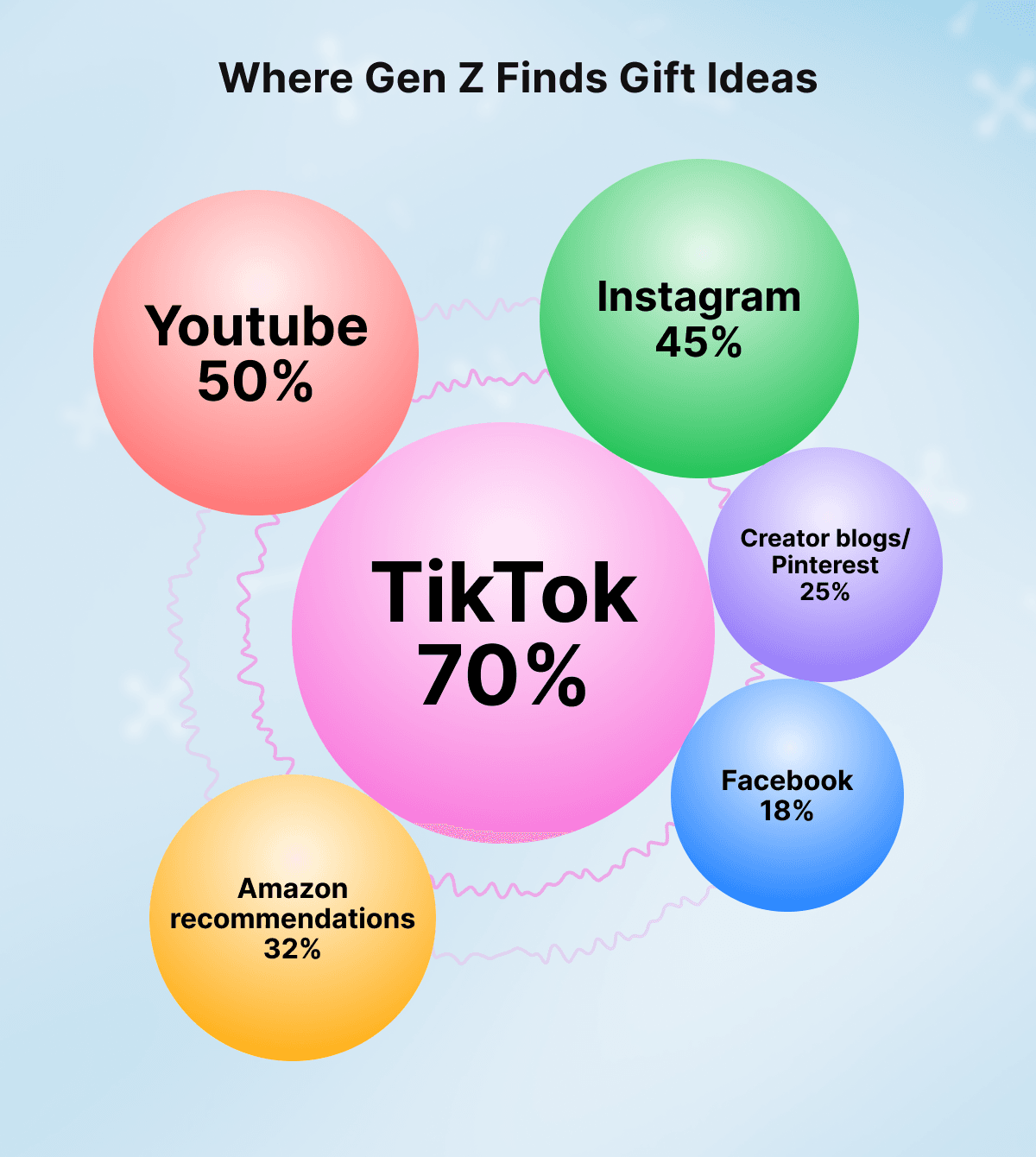
Here’s what actually resonates with them this season.
1. Authenticity Beats Aesthetics
Gen Z connects with content that feels real and unfiltered. User-generated videos, casual behind-the-scenes clips or creator-style photos outperform studio shoots.
Tip: Use MGID’s Generative AI to produce ad variations that mimic organic posts — simple backgrounds, real textures and natural tones. Keep headlines conversational (“I actually love this,” “Found it before it sold out”).
2. Values Matter More Than Slogans
Gen Z shops with purpose. They look for brands that care about sustainability, inclusivity or social causes. Empty “eco” labels don’t work, transparency does.
Tip: Segment by values as much as by demographics. Feature sustainability badges, diversity in creatives or small-business stories. Even subtle signals (“wrapped in recycled paper”) can drive higher engagement.
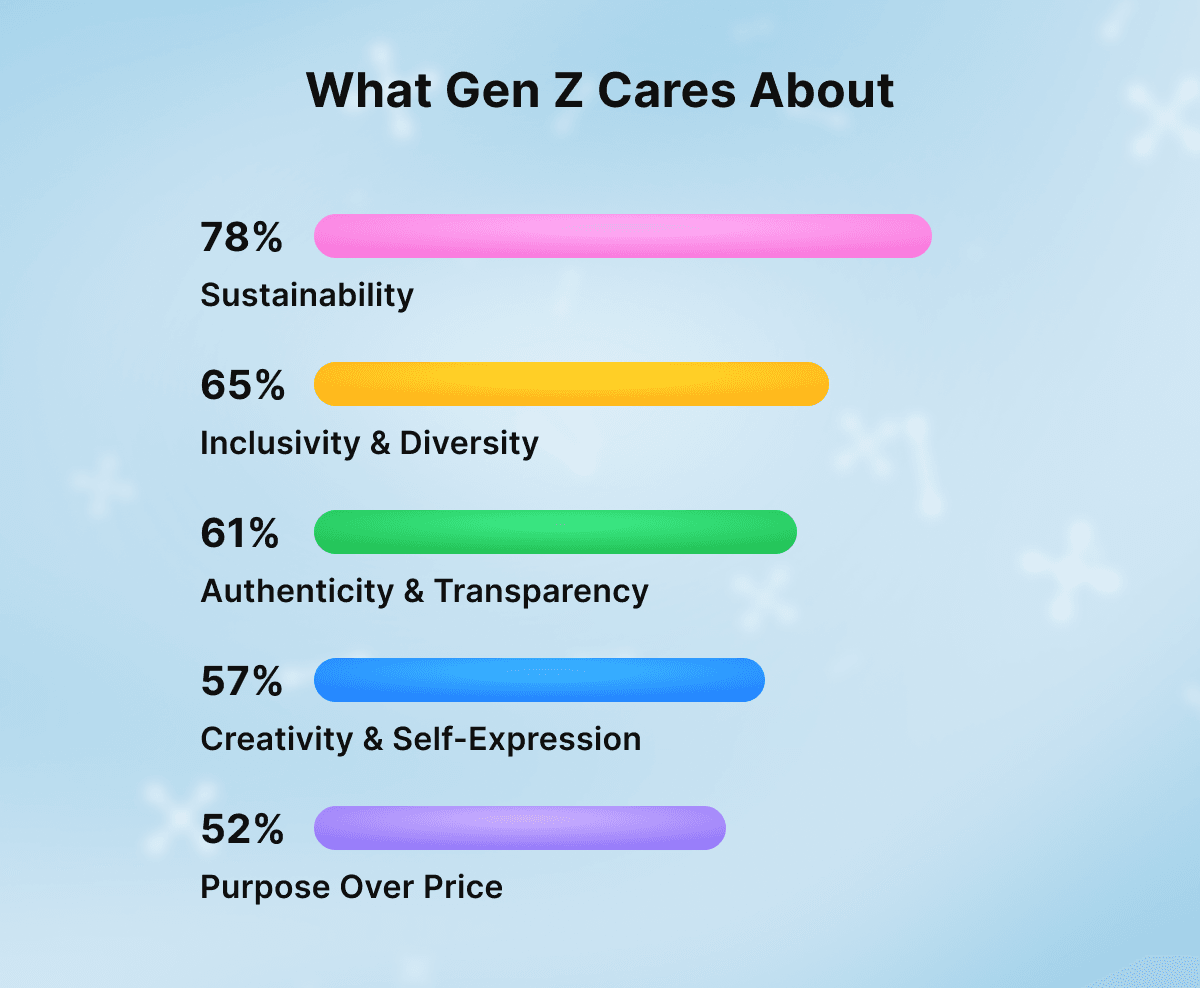
3. Short, Smart and Scroll-Proof Content
Attention spans may be short (approximately 8 seconds on average), but curiosity is huge. Fast-paced hooks, vertical videos and native-style copy keep them engaged.
Tip: Front-load your message in the first 2 seconds. Use motion or a question (“Would your best friend love this?”). Let MGID’s CTR Guard auto-refresh variations when vCTR dips: it keeps content fresh before boredom sets in.
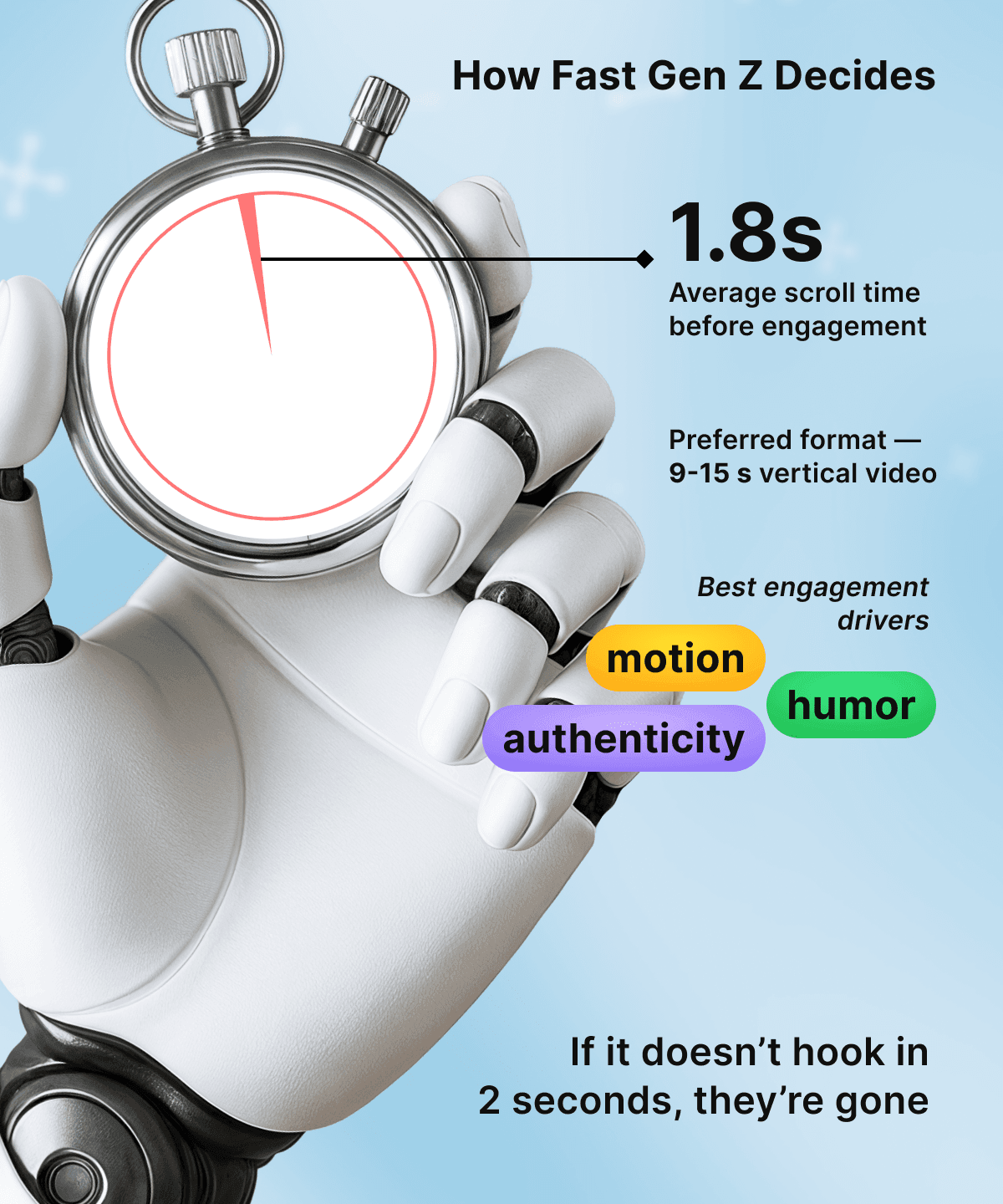
4. Community Over Celebrity
Gen Z places their trust in creators who feel authentic and relatable. Micro-influencers and relatable faces build more credibility than polished ads. Partnership ads or creator-led content consistently outperform business-as-usual assets.
Tip: Mix AI-generated visuals with real creator snippets. Run A/B tests to find which tone (playful, educational, heartfelt) converts best, then scale with CPA Tune (another tool developed by MGID) once winners emerge.
5. Mobile-First Everything
Almost all Gen Z discovery and buying happens on phones. If your landing page loads slowly or your layout breaks on mobile, you’ve already lost them.
Tip: Keep mobile load time under 2.5 s, show shipping cut-offs above the fold and use sticky CTAs.
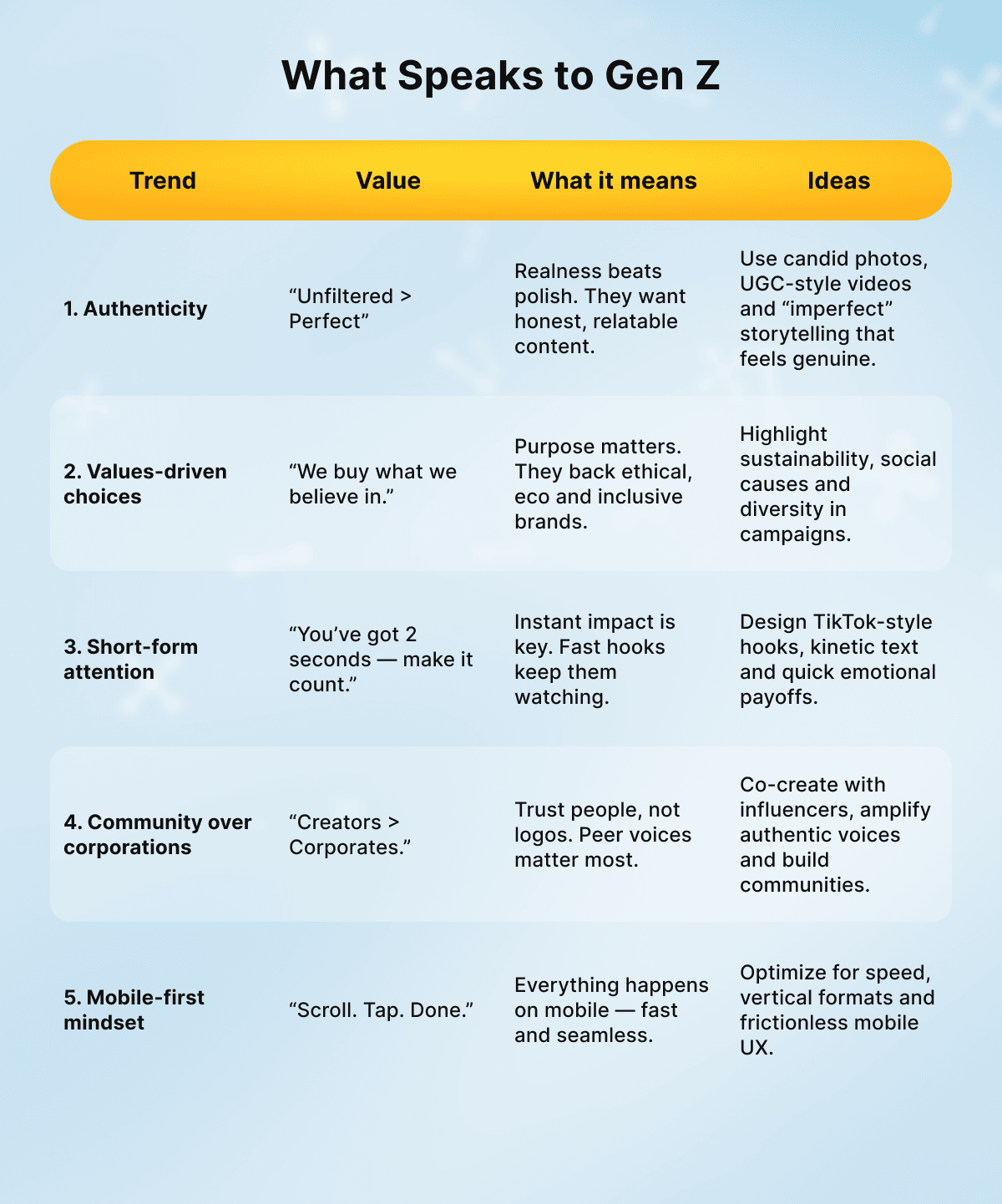
In short: Gen Z responds to brands that listen, adapt and reflect their identity, rather than those that simply push a sale.
Chapter 5
How Brands Are Unleashing AI in Holiday Marketing
As shoppers turn to AI for help, brands are racing to keep up. The same algorithms that recommend gifts are now driving personalized campaigns, smarter budgets and faster creative testing behind the scenes.
Here’s how marketers are using AI to win the holiday season.
Personalization at Scale
Holiday campaigns focus on creating one-to-one moments rather than addressing broad audiences. According to Databricks, retailers are using generative AI to automatically create customized product descriptions, emails and recommendations for millions of users at once.
Brands that master this approach can move beyond “segments” and start speaking to each shopper individually.
Smarter Ad Automation
During the peak shopping months, speed is everything. Meta’s Advantage+ suite, for instance, uses AI to optimize budgets and bidding in real time, helping advertisers lower their cost per conversion by up to 7%.
Across the industry, about 80–89% of online retailers now use AI in some form, from recommendation engines to chatbots and dynamic pricing tools. And it’s paying off: AI-powered personalization can increase revenue by as much as 40%.
Predicting Demand Before It Happens
AI transforms selling into predicting. By analyzing historical data, seasonal patterns and even weather, retailers can now predict which products will spike and when. That means fewer “out-of-stock” moments and smarter logistics, a huge advantage in the high-pressure holiday window.
Real-Time Insights and Instant Creative Tweaks
Holiday campaigns move fast, and so does AI. Instead of waiting weeks for results, marketers can now A/B test hundreds of creative variations automatically. In doing so, algorithms can pause underperforming ads and boost the ones that convert. In a season where every impression counts, real-time optimization can make or break a campaign.
AI-Powered Discovery and Assistants
AI is also changing how people find products. Voice and visual search are growing fast: DHL’s 2025 E-commerce Trends Report found that 37% of global shoppers use AI assistants or voice search when shopping online. In addition, 39% of consumers, according to Salesforce, now use AI to discover new products, with Gen Z leading the charge.
When guided by AI, 47% of shoppers complete purchases faster because they receive fewer irrelevant options and more tailored suggestions.
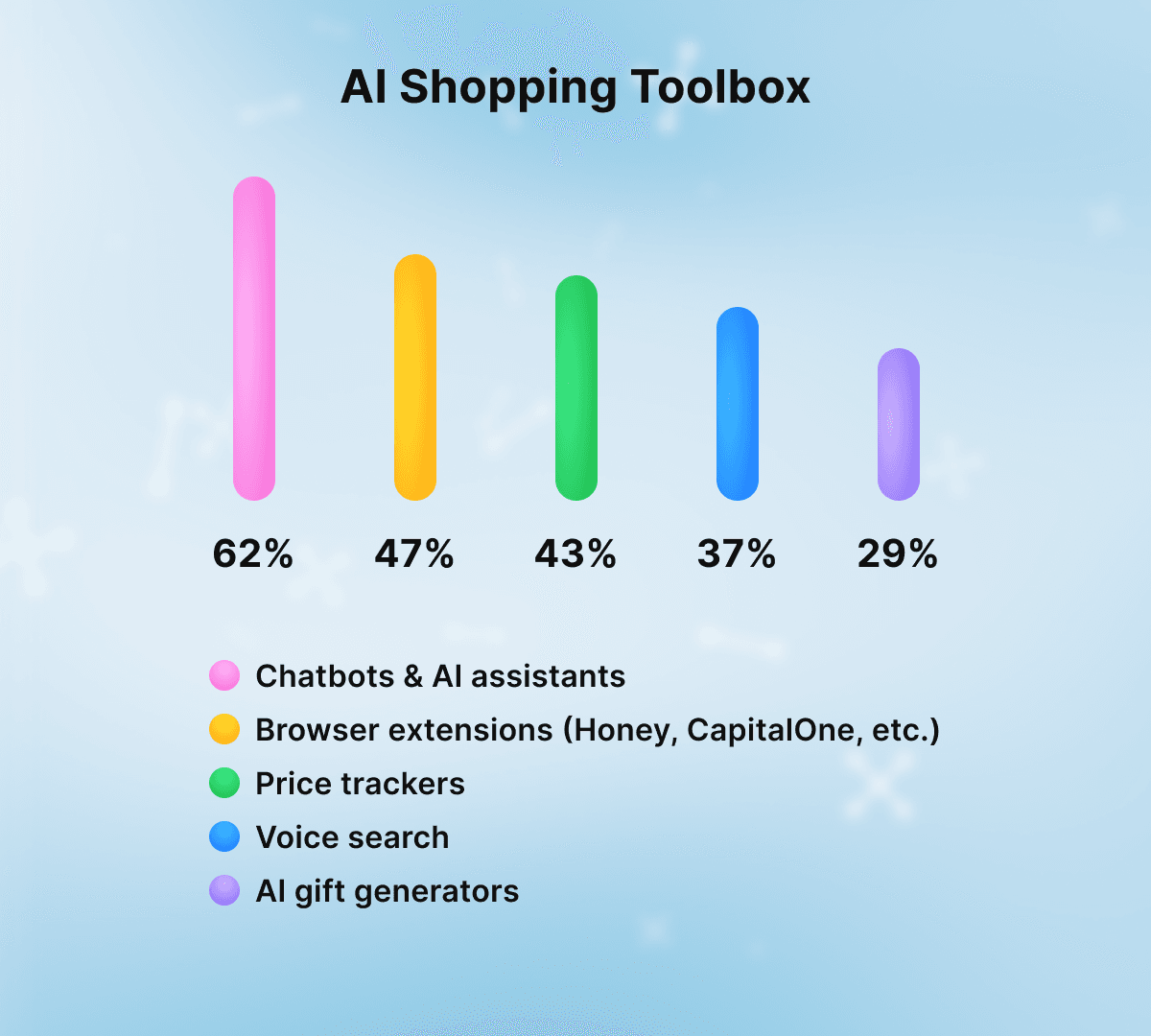
Chapter 6
Making AI Work for You: MGID Holiday Playbook
AI isn’t only for retail giants. Here’s a quick, practical way to activate MGID’s Generative AI toolset across the holiday funnel.
Boost Creativity at Scale With MGID’s Generative AI
Turn audience insights into on-brand assets in minutes.
Prompt formula (copy/paste):
Create 2 native ad creatives for [vertical] targeting [audience]. Angle: [benefit/seasonal tension]. Tone: [warm/playful/minimalist]. Include 2 headlines (<40 chars), 1 description (<90 chars), and 1 image concept per creative. Avoid overused holiday clichés (snowflakes, red-green palette). Offer: [X% off/free ship/bundle]. Must feel giftable.
Ready-to-use angles (pick 2–3):
- “Gift the vibe, not the item” (experience-first gifts)
- “Early birds, better gifts” (June–Oct shoppers)
- “Eco & thoughtful” (values-led bundles)
- “Self-care stocking stuffers” (treat-yourself)
- “Under $25 / $50 / $99” (price-tier discovery)
Headline starters (short, scroll-stopping):
- “Found your cozy gift.”
- “Skip the rush, shop now.”
- “Little price. Big smile.”
- “Gifts with a story.”
- “Eco picks they’ll keep.”
Image directions (to brief or generate):
- Minimal scene + one hero product + soft sparkle bokeh
- Flat-lay gift kit with handwritten tag “For [you]”
- Cozy hands + product in frame (no faces, keep native-friendly)
- Bold color block + tiny festive icon (no cliché overload)
Creative tip: Generate 12–18 assets up front, then A/B the top 6 by CTR and add-to-cart for the first 72 hours.
Next, MGID’s AI-driven performance prediction tool helps you identify which creatives are most likely to perform before your campaign even launches.
It analyzes your ad titles and visuals in real time, scoring them from Poor to Excellent based on design elements and targeting settings.
Use it to:
- Quickly filter out underperforming concepts before going live.
- Refine your top headlines and images for maximum CTR.
- Save budget and accelerate optimization during the critical holiday window.
Pro tip: Pair performance prediction insights with your initial Generative AI batches — generate, predict and then only test the top-scoring assets.
Keep Engagement High With CTR Guard
Holiday campaigns burn out fast: average CTR drops about 15% within a week. CTR Guard uses generative AI to spot that decline and automatically produce fresh ad variations to restore engagement.
Practical setup:
- Enable CTR Guard from day one for product or search-feed campaigns.
- The system auto-triggers when a creative’s vCTR falls ≥15% for 3 days in a row, or your campaign runs with fewer than 3 active ads.
- When triggered, CTR Guard generates 3 new creatives based on your top performer.
- You’ll receive dashboard and email alerts and can review, edit or auto-launch new versions from the CTR Guard Panel.
What to monitor:
- vCTR recovery after refresh (compare before/after 3 days)
- Add-to-cart rate of AI vs. manual creatives
- Creative rotation health: keep 4–6 active ads live to prevent fatigue
Tip: Turn on Auto-Launch during the holiday rush to avoid downtime, but we recommend capping each AI creative at ~300 clicks for testing. CTR Guard pauses generation automatically if new ads stay unlaunched — no spam, just smart refreshes.
CTR Guard Holiday Strategies
This season, CTR Guard is expanding with a series of holiday-specific generation strategies, designed to help advertisers quickly refresh their creatives with festive, event-driven variations. Each strategy focuses on generating seasonal headlines while keeping the original teaser visuals unchanged. Expect dedicated strategies for major moments like Black Friday, Christmas, Valentine’s Day and beyond.
The first available strategy, Black Friday, launches on November 10 (active until November 29) and is available under Manual Strategies for Product Campaigns.
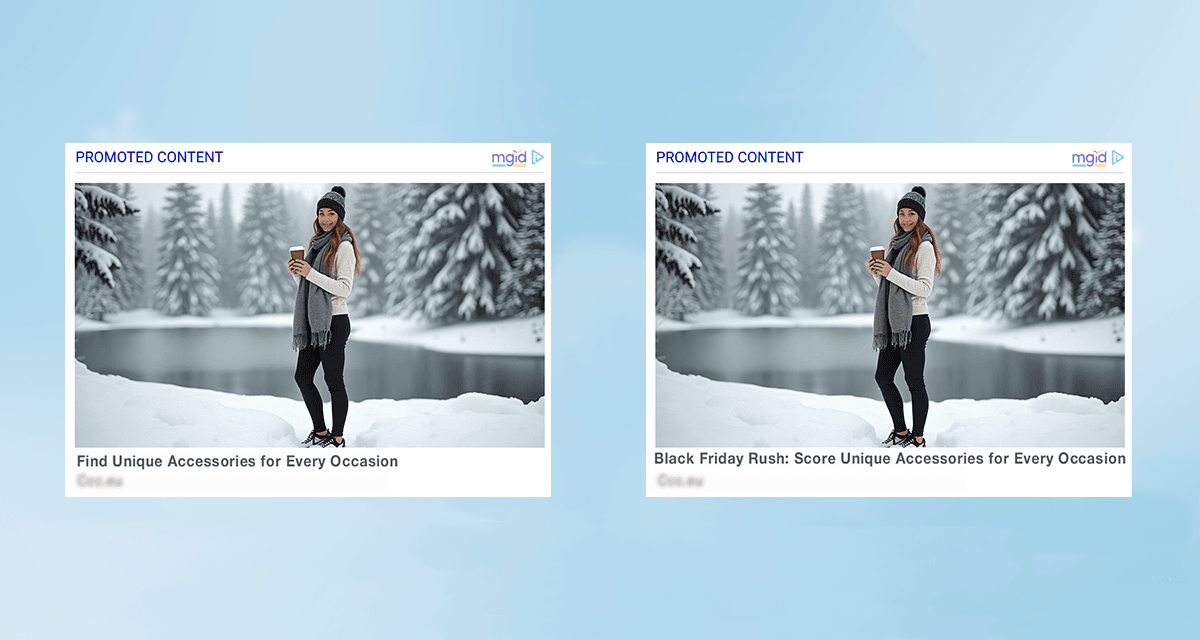
What it does
It generates new, high-performing holiday-themed titles for your existing creatives, keeping your proven visuals intact while adding a timely Black Friday twist.
Example output
Original teaser → New headlines such as:
- “Black Friday Deal You Can’t Miss”
- “Gift Smarter. Save Bigger.”
- “This Deal Won’t Wait — Black Friday Starts Now!”
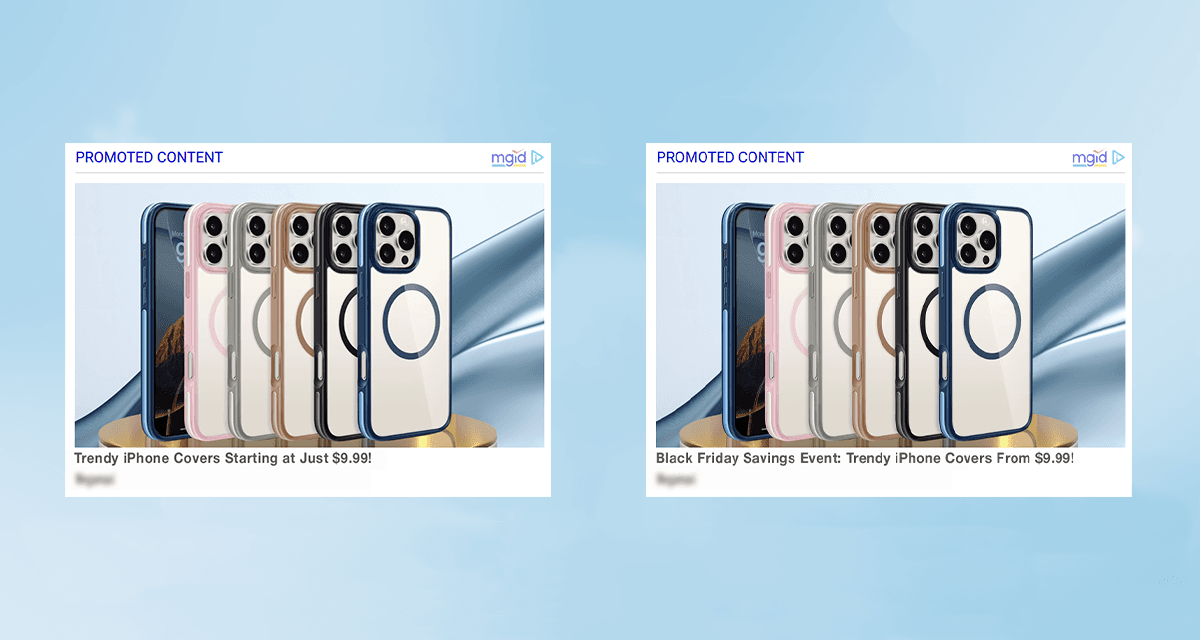
Why it matters
With shoppers scrolling faster than ever, small creative refreshes can make a big impact. The holiday strategy helps your best-performing ads stay relevant, timely and emotionally in tune with the season, all without starting from scratch.
Tip: Try the Black Friday strategy early to warm up audiences before the rush. More holiday versions (including Christmas and New Year) will roll out soon to keep your creatives festive all season long.
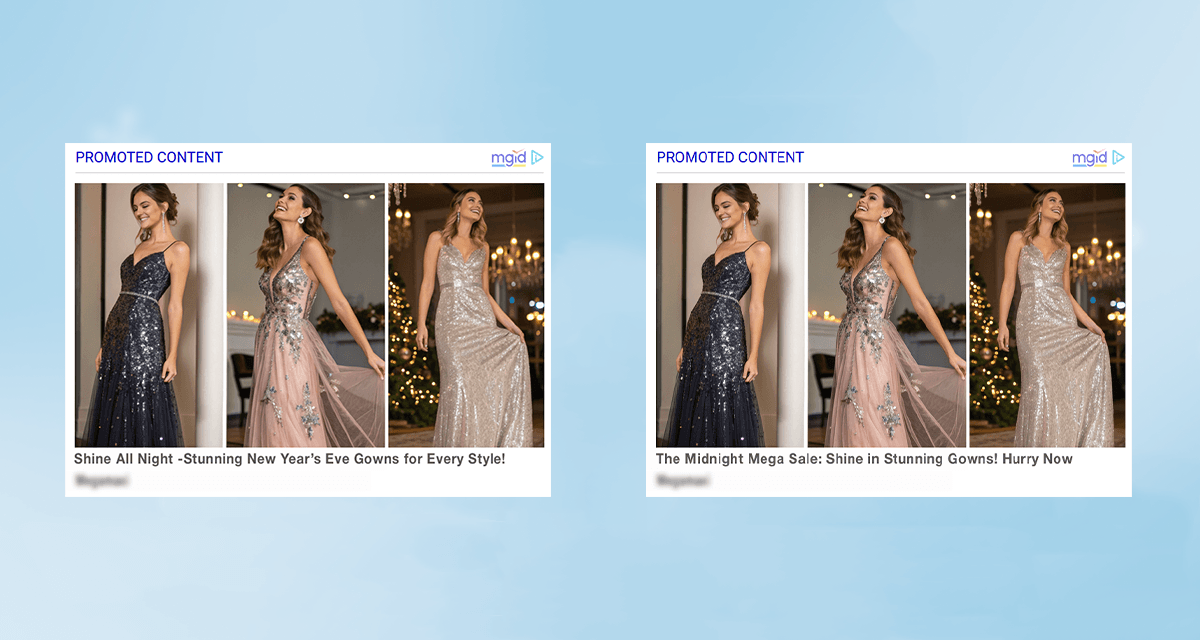
Hit Profitability With CPA Tune
Forget chasing clicks — CPA Tune uses machine learning to hit your conversion goals while on a CPC model.
How to start:
- Choose CPA bidding and set a target CPA based on past data.
- Allocate a daily budget 5–7× target CPA so the algorithm can learn.
- Feed clean conversion events (purchase, lead, add-to-cart with value).
- Keep targeting broad for the first 7–14 days — CPA Tune learns fast once it hits ~10 conversions.
When to adjust:
- If CPA is higher than the target by 15 percent or more for 3 consecutive days, review the weakest audience segments or ad creatives and update the rotation. CTR Guard can help identify underperforming elements.
- If CPA stays below the target for 3 consecutive days and the average order value (AOV) remains stable, increase the budget for the best-performing campaigns by 20 to 30 percent. Avoid doubling the budget overnight.
Tip: Start with a CPA about 20% higher during learning. Once stable, tighten gradually. Pair CPA Tune with a “gift-set” upsell to raise AOV: higher cart values make the algorithm’s efficiency even stronger.
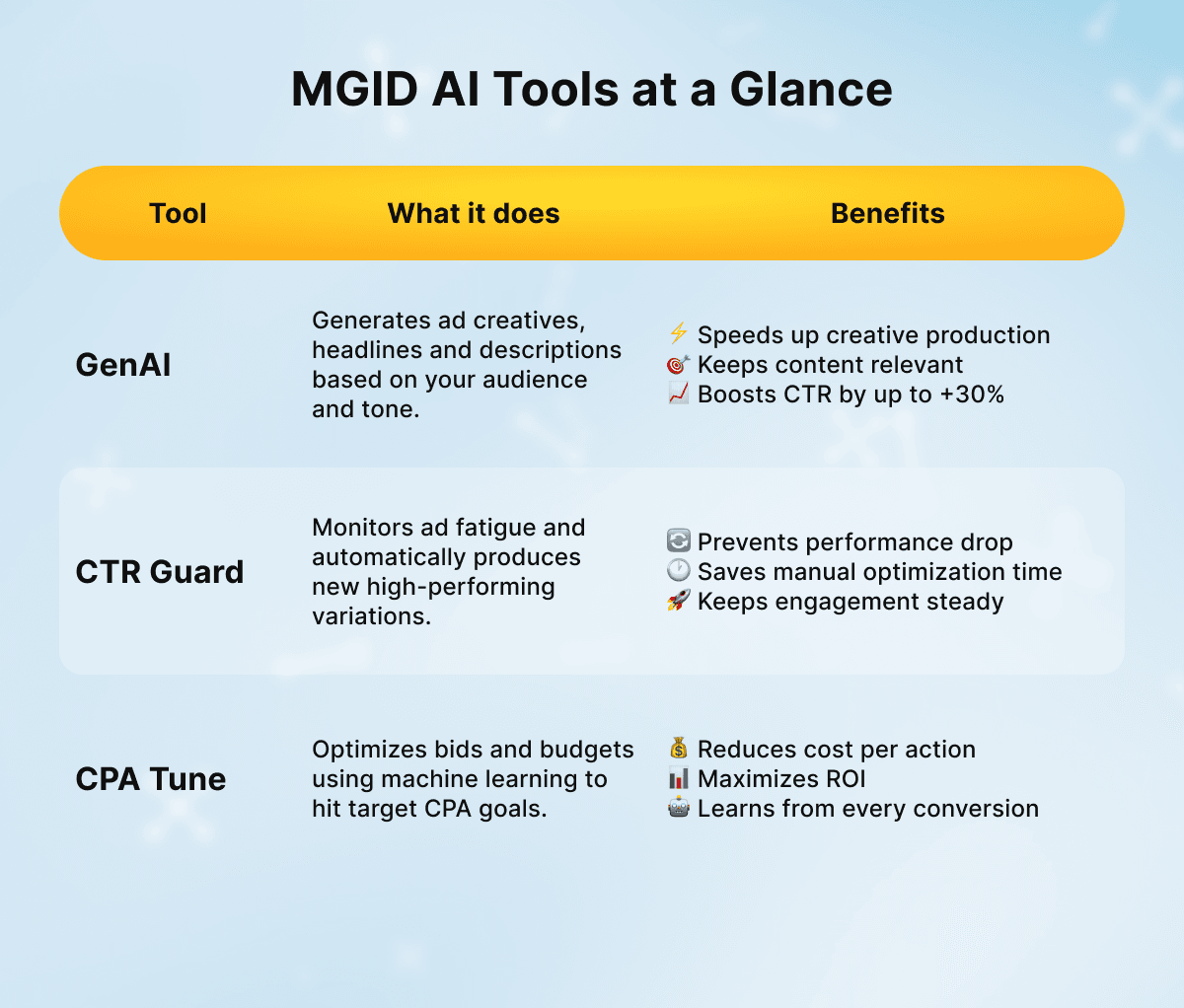
Convert Holiday Traffic With Optimized Landing Pages
Most holiday fails occur after the click, when users reach a page that loads slowly, feels untrustworthy or doesn’t guide them toward the right gift.
Checklist (5-minute QA):
- Speed: Aim for a mobile LCP under 2.5 seconds. Even a one-second delay can kill intent during the holiday rush. Compress images, preload key visuals and keep scripts light to make the experience feel instant.
- Above the fold: Everything a shopper sees before scrolling should make it immediately clear why they should buy. Show the price and value proposition, highlight key benefits and reinforce trust with reviews, testimonials or “as seen on” badges. Include visible shipping and delivery information right at the top.
- Holiday trust: People buying gifts want confidence, not surprises. Add clear delivery cut-off dates, emphasize your return policy and reassure shoppers that giftable = refundable. Even a small line like “Hassle-free returns until January 15” builds confidence.
- Bundles: Make gifting easier with curated gift sets by persona or price range, for example, “Under $50,” “For Him,” or “For Homebodies.” It shortens decision time and lifts your average order value at the same time.
- Social proof: If possible, display real-time purchase cues such as “142 people bought this in the last 24 hours” or recent review snippets. These signals create momentum and help hesitant shoppers feel reassured they’re choosing the right product.
Tip: Add a small “Gift Finder” widget that asks for a few quick inputs (budget, recipient and vibe) and then suggests a pre-filled cart or shortlist of items. It dramatically cuts time-to-decision and keeps users in a festive buying mood.
Blend in Discovery Feeds With Native Placements
MGID native shines in the mid-funnel. This is the discovery stage where holiday intent is just starting to form. Shoppers aren’t searching for a specific product yet; rather, they’re looking for ideas, inspiration and validation. The goal here is to spark curiosity and gently guide them toward your offer.
Use cases:
- Value-led content: Create editorial-style pieces that highlight smart or thoughtful choices (“Gifts under $50,” “Eco-friendly picks for conscious shoppers” or “Most-loved stocking stuffers”). These attract readers who are browsing for inspiration, not yet ready to buy.
- Problem/solution stories: Position your product as the answer to a seasonal pain point, for example, “How to get last-minute gifts delivered on time” or “The stress-free way to shop for everyone on your list.” Framing it around ease, convenience or relief performs especially well in December.
- Lifestyle stories: Tell small, emotional stories that show how the gift fits into a moment, like “The cozy gift that makes winter mornings better” or “A little luxury that turns gifting into self-care.” Use imagery and tone that blend seamlessly with surrounding publisher content.
- Smart retargeting: Retarget readers who scrolled at least halfway through your content or spent 30+ seconds engaging — these are signals of real interest. Serve them product-focused native or display ads within 24–48 hours while the idea is still fresh.
- Budget protection: Exclude users who have already purchased to avoid wasted spend. Instead, re-engage them later with upsell, bundle or gift-for-you offers once the first conversion is complete.
Tip: Pair native discovery with a lightweight holiday lead magnet, like “Get our 2025 Gift Finder in your inbox”, to build an email retargeting audience you can warm up as the season peaks.
In short: AI has officially become the infrastructure of holiday marketing.
Chapter 7
Real-World Success Stories
For brands that use it wisely, AI is a powerful growth engine.
- e.l.f. Beauty used AI-powered personalization across email, SMS and app notifications to deliver “beauty recaps” — customized year-in-review experiences for each customer. The campaign saw double-digit engagement growth and record repeat purchases.
- Castlery, a furniture retailer, tested Meta’s Advantage+ partnership ads with creator-led Reels. The AI-optimized campaign achieved a 4× return on ad spend and a 78% lower cost per purchase.
- Sephora uses its AI assistant to provide tailored gift suggestions and “beauty profiles” across channels. The AI-powered personalization contributed to a 15% increase in conversion rates, a 20% rise in customer satisfaction and a 25% boost in average order value, significantly enhancing the shopping experience and sales performance.
Tip: Don’t try to automate everything at once. Start with one area, like recommendations or bidding, and let AI learn from small and focused experiments before scaling.
Chapter 8
Measuring AI-Driven Holiday Success
AI can make campaigns faster and smarter, but only if you track the right signals. Forget vanity metrics like impressions or likes. Focus on what AI actually moves.
Key KPIs to watch:
- Conversion lift: Compare sales from AI-optimized vs. manual campaigns.
- Average order value (AOV): AI personalization often increases basket size.
- Engagement quality: Measure click-to-purchase or add-to-cart rate, not just CTR.
- Recommendation adoption: How many AI-driven suggestions turn into actual sales?
- Time to conversion: AI tends to shorten the decision process, so watch for that drop.
| Metric | Formula | Description |
|---|---|---|
| AOV (Average order value) | Total revenue ÷ Number of orders | Shows how much each shopper spends per order. |
| Conversion lift | (AI campaign conversions – Manual) ÷ Manual × 100% | Measures improvement from AI optimization. |
| Time to conversion | Click → Purchase duration | Shorter = faster decision journey. |
Tip: Create an “AI performance dashboard.” Even simple weekly tracking of AOV and conversion lift reveals how effectively automation supports both your team and your results.
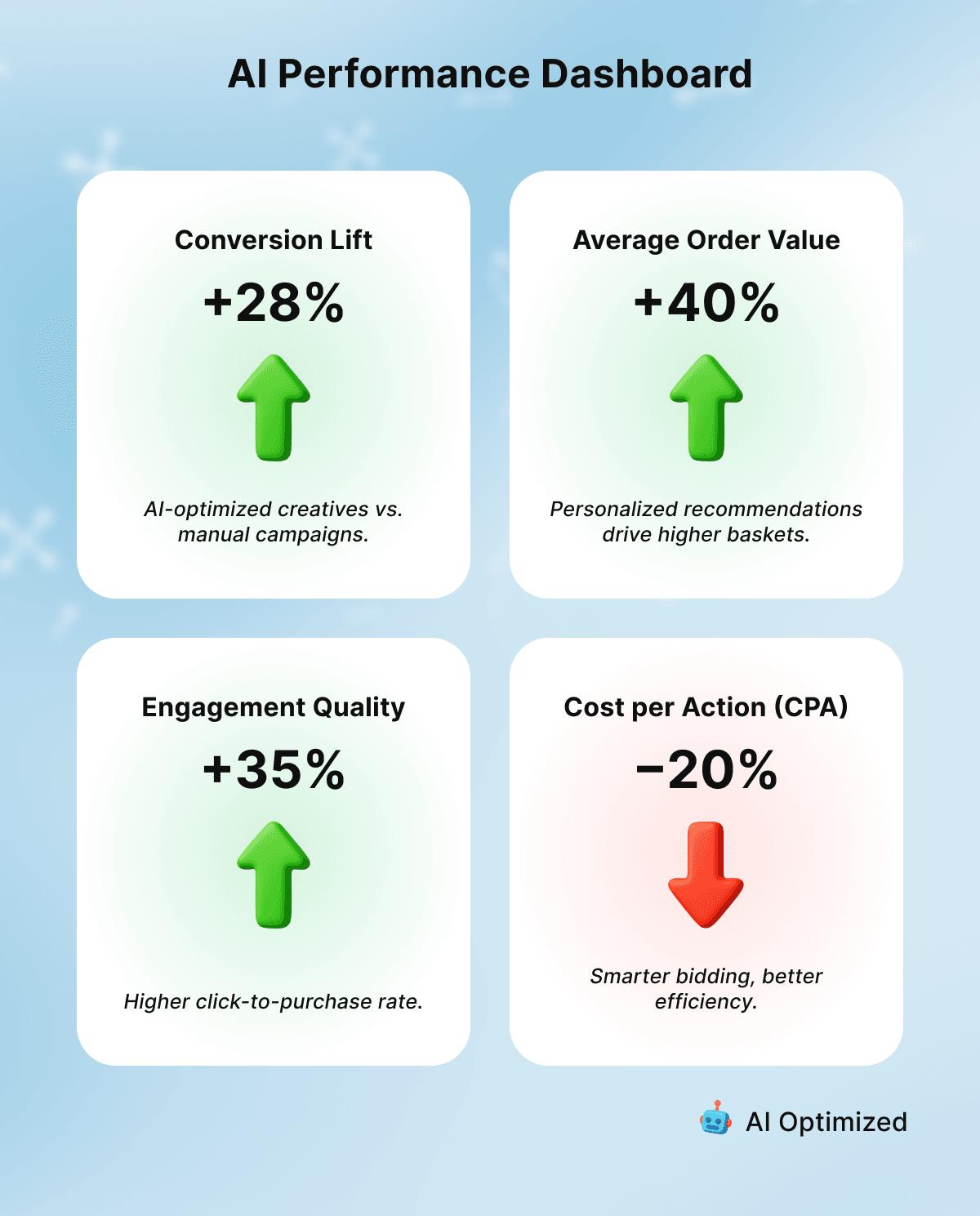
Chapter 9
Balancing AI With Human Creativity and Trust
AI can analyze data, predict trends and craft a thousand ad variations in seconds. What it can’t do, at least not yet, is feel the emotion behind a holiday gift, or understand why someone buys a candle not for the scent, but for the story.
That’s why the next phase of holiday marketing isn’t about replacing people with algorithms, but about pairing machine efficiency with human empathy.
Keep the Human in Personalization
AI can segment your audience down to micro-moments, but real connection still comes from tone and authenticity. Instead of letting the model write your entire email campaign, use it to suggest variations or headlines, then refine the copy to sound like your brand’s voice.
Tip: Let AI brainstorm, not broadcast. Use it to create first drafts or A/B options, but always add your own emotional layer before hitting “publish.”
Be Transparent About AI Use
Consumers, especially Gen Z, value honesty. If your chatbot, virtual stylist or recommendation engine uses AI, state that clearly. People are more open to AI when they understand how it works and how their data is protected.
Tip: Add a short disclosure like “Powered by AI for smarter suggestions” on your digital touchpoints. It builds trust instead of suspicion.
Use Data Ethically
AI runs on data, and trust runs on transparency. Avoid over-tracking and focus on consensual personalization, using information shoppers willingly share, like wish lists or browsing behavior.
Tip: Audit your data collection once per season. Remove fields you don’t need and clearly show users how their data improves their experience.
Let AI Handle the Heavy Lifting, Not the Heart
Automation empowers your team to focus on creativity. Let AI analyze performance, optimize budgets or write product summaries, so your people can focus on storytelling and emotion.
Tip: Set a “human creativity quota.” For every AI-generated asset, require one human-crafted piece that focuses purely on narrative or design.
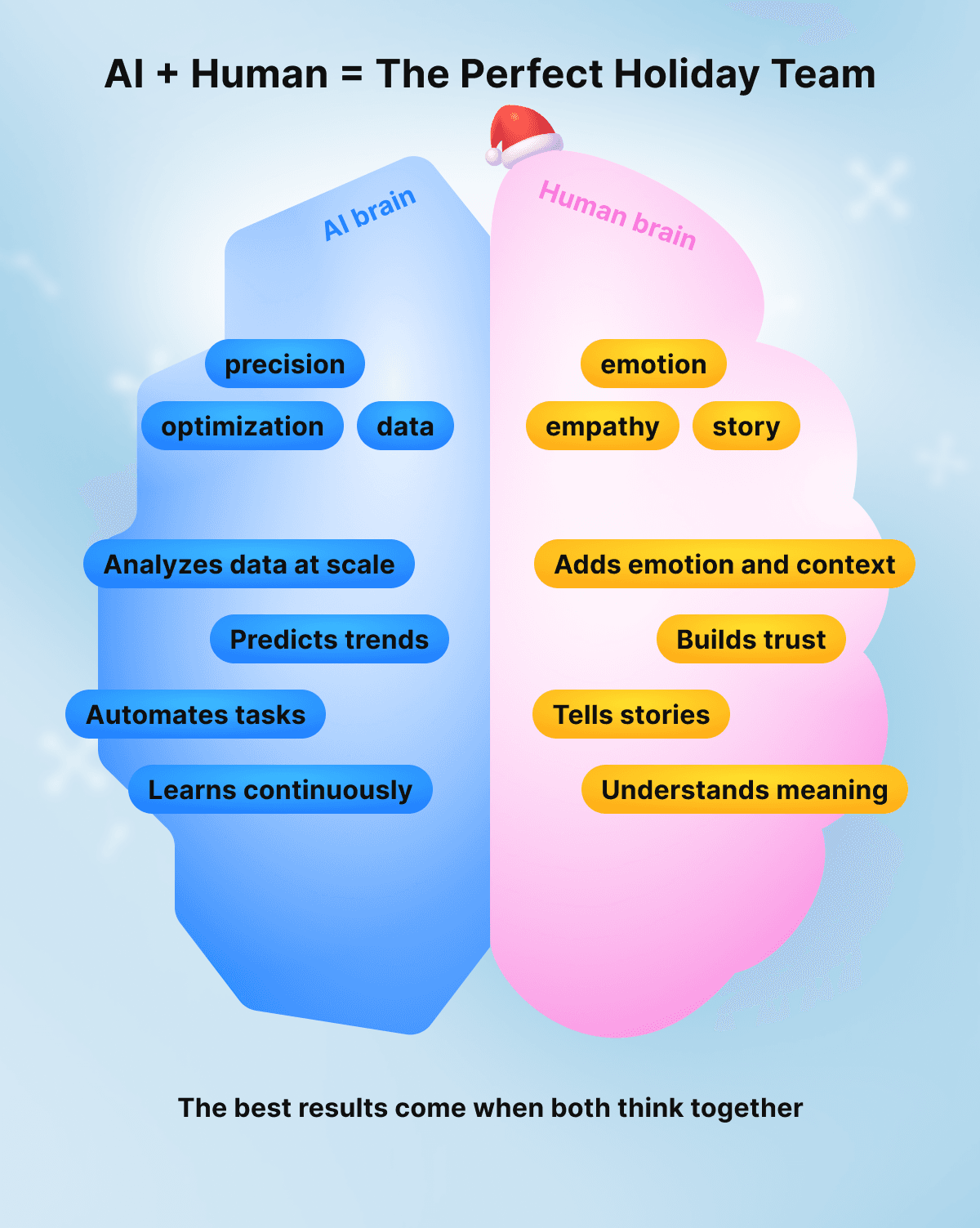
In short: AI is your co-pilot — it can steer through data storms, but you’re still the one setting the destination.
Chapter 10
Looking Ahead: The Future of AI and Holiday Marketing
The line between shopping, social and storytelling is blurring fast. By next holiday season, AI will power entire experiences, not just recommendations. We’ll see smarter visual search (“find me gifts that look like this”), hyper-personalized shopping journeys and creative campaigns that evolve in real time based on audience mood and context.
The tech will get more conversational, too. AI assistants like Amazon’s Rufus or Walmart’s Sparky are already shaping how people browse, compare and buy. In 2026, expect even more voice-led and visual discovery tools, predictive gift guides and “memory-based” personalization, where AI remembers your past choices and curates a holiday list before you even start looking.
However, no matter what, the core principle won’t change: the most successful brands will be the most human ones. Those that blend AI precision with empathy, humor and creativity will earn loyalty that no algorithm can fake.
The holidays have always been about connection. Now, with AI as part of the mix, marketers have a new superpower: the ability to make every interaction feel personal at scale. So remember, AI might predict what your audience wants, but it’s your brand that makes them feel something when they find it.





